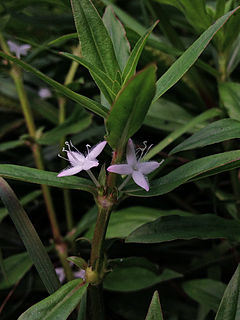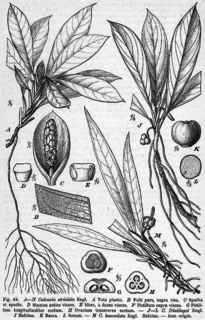Microdesmis is a genus of plant of the family Pandaceae. It is native to tropical Africa, China and Southeast Asia.
- Microdesmis afrodecandraFloret, A.M.Louis & J.M.Reitsma - Gabon
- Microdesmis camerunensisJ.Léonard - Cameroon, Gabon, Congo-Brazzaville
- Microdesmis caseariifoliaPlanch. ex Hook -Guangdong, Guangxi, Hainan, Yunnan, Bangladesh, Cambodia, Borneo, Sumatra, Laos, Malaysia, Myanmar, Philippines, Thailand, Vietnam
- Microdesmis haumanianaJ.Léonard - Gabon, Congo-Brazzaville, Zaïre, Angola
- Microdesmis kasaiensisJ.Léonard - Zaïre
- Microdesmis keayanaJ.Léonard - Benin, Ghana, Guinea, Ivory Coast, Liberia, Sierra Leone, Togo, Nigeria
- Microdesmis klaineiJ.Léonard - Gabon
- Microdesmis magallanensis(Elmer) Steenis - Luzon, Sibuyan
- Microdesmis pierlotianaJ.Léonard - Cameroon, Gabon, Congo-Brazzaville, Zaïre, Central African Republic
- Microdesmis puberulaHook.f. ex Planch - widespread across central Africa from Nigeria east to Uganda, south to Angola
- Microdesmis yafunganaJ.Léonard - Zaïre
Crotonogyne is a shrub of the spurge family (Euphorbiaceae) first described as a genus in 1864. It is native to western and central Africa.

Diodia is a genus of flowering plants in the Rubiaceae family. It was described by Carl Linnaeus in 1753. The genus is found from southern and eastern United States, South America, Central America, Mexico, the West Indies and tropical Africa.
Oldfieldia is a plant genus under the family Picrodendraceae, the only member of its subtribe (Paiveusinae). It was described as a genus in 1850.

Nephthytis is a genus of eight species of flowering plants in the family Araceae, native to tropical western Africa, with one species in Borneo.
Magnistipula is a genus of plant in family Chrysobalanaceae described as a genus in 1905.
Pleioceras is a genus of plant in family Apocynaceae, first described as a genus in 1888. It is native to tropical Africa.
Eremospatha is a genus of climbing flowering plants in the palm family found in tropical Africa. These rattans are uncommon in cultivation and poorly understood by taxonomists;. Closely related to Laccosperma, they are unique in the Calameae tribe by the near complete absence of bracts and bracteoles. The name is from Greek meaning "without a spathe".

Anchomanes is a genus of flowering plants in the family Araceae. The genus is native to tropical Africa.

Stylochaeton is a genus of flowering plants in the family Araceae that is endemic to Africa. Stylochaeton are rhizomatous with hastate leaves. Flowering in this genus is said to be quite uncommon.
- Stylochaeton angolenseEngl. - Angola
- Stylochaeton bogneriMayo - Kenya, Tanzania
- Stylochaeton borumenseN.E.Br. - Kenya, Tanzania, Mozambique, Zambia
- Stylochaeton crassispathumBogner - Tanzania
- Stylochaeton cuculliferumPeter - Zaïre, Tanzania, Zambia, Malawi
- Stylochaeton euryphyllumMildbr. - Tanzania, Mozambique
- Stylochaeton grandeN.E.Br. - Somalia
- Stylochaeton hypogeumLepr. - Benin, Burkina Faso, Ivory Coast, Mauritania, Senegal, Nigeria, Chad, Ethiopia, Sudan
- Stylochaeton kornasiiMalaisse & Bamps - Zaïre
- Stylochaeton lancifoliumKotschy & Peyr. - Benin, Burkina Faso, Guinea, Ivory Coast, Mali, Nigeria, Niger, Senegal, Togo, Cameroon, Central African Republic, Chad, Sudan
- Stylochaeton malaisseiBogner - Zaïre
- Stylochaeton milneanumMayo - Tanzania
- Stylochaeton natalenseSchott - Tanzania, Malawi, Mozambique, Zimbabwe, Swaziland, northern South Africa
- Stylochaeton oligocarpumRiedl. - Ogaden region of eastern Ethiopia
- Stylochaeton pilosumBogner - Sierra Leone
- Stylochaeton puberulumN.E.Br. - Kenya, Tanzania, Mozambique, Zambia, Zimbabwe
- Stylochaeton salaamicumN.E.Br. - Kenya, Tanzania
- Stylochaeton shabaenseMalaisse & Bamps - Zaïre
- Stylochaeton tortispathumBogner & Haigh - Mozambique
- Stylochaeton zenkeriEngl - Zaïre, Congo-Brazzaville, Equatorial Guinea, Cameroon, Sierra Leone

Culcasia is a genus of flowering plants in the Araceae family, native to tropical Africa. Most of its species are climbers and resemble Cercestis except for the fact that they don't produce flagella.
- Culcasia angolensisWelw. ex Schott - western + central Africa from Senegal to Angola
- Culcasia annetiiNtépé-Nyamè - Ivory Coast, Cameroon, Liberia
- Culcasia bosiiNtépé-Nyamè - Cameroon, Gabon, Congo-Brazzaville
- Culcasia brevipetiolataBogner - Gabon
- Culcasia caudataEngl. - Zaïre
- Culcasia dinklageiEngl - western + central Africa from Liberia to Zaïre
- Culcasia ekongoloiNtépé-Nyamè - central Africa from Nigeria to Zaïre
- Culcasia falcifoliaEngl. - central Africa from Gabon east to Tanzania and south to Mozambique
- Culcasia glandulosaHepper - Ivory Coast, Sierra Leone, Liberia, Congo-Brazzaville
- Culcasia insulanaN.E.Br. - Zaïre, Cameroon, Gulf of Guinea Islands
- Culcasia lanceolataEngl. - Cameroon, Gabon
- Culcasia libericaN.E.Br. - Ivory Coast, Sierra Leone, Liberia, Togo
- Culcasia linearifoliaBogner - Cameroon, Gabon
- Culcasia loukandensisPellegr - Cameroon, Gabon, Congo-Brazzaville, Zaïre, Central African Republic
- Culcasia mannii(Hook.f.) Engl. - Cameroon, Gabon, Congo-Brazzaville, Nigeria, Equatorial Guinea
- Culcasia obliquifoliaEngl. - Cameroon, Gabon
- Culcasia orientalisMayo - Kenya, Tanzania, Mozambique, Zambia
- Culcasia panduriformisEngl. & K.Krause - Cameroon, Gabon
- Culcasia parvifloraN.E.Br. - western + central Africa from Liberia to Zaïre
- Culcasia rotundifoliaBogner - Gabon
- Culcasia sanagensisNtépé-Nyamè - Cameroon
- Culcasia scandensP.Beauv. - western + central Africa from Liberia to Angola
- Culcasia seretiiDe Wild - western + central Africa from Liberia to Zaïre
- Culcasia simiarumNtépé-Nyamè - western Africa from Ivory Coast to Cameroon
- Culcasia striolataEngl. - western + central Africa from Liberia to Congo-Brazzaville
- Culcasia tenuifoliaEngl. - western + central Africa from Liberia to Zaïre
- Culcasia yangambiensisLouis & Mullend. - Congo-Brazzaville, Zaïre
Ancistrorhynchus is a genus of flowering plants from the orchid family Orchidaceae. It contains 16 species native to tropical Africa.
Cuviera is a genus of flowering plants in the Rubiaceae family native to tropical Africa. It was originally described by Augustin Pyramus de Candolle in 1807 and is named after the French naturalist Georges Cuvier.
Craterispermum is a genus of flowering plants in the Rubiaceae family. It contains 16 species that occur in tropical Africa and Seychelles. It is the only genus in the tribe Craterispermeae, of which the divergence time is estimated at 34.8 million years ago.
Callichilia is a genus of plant in the Apocynaceae family native to tropical Africa.

Pleiocarpa is a genus of plant in the Apocynaceae family first described as a genus in 1876. It is native to tropical Africa from Senegal to Tanzania and south to Zimbabwe. As of August 2013 the World Checklist of Selected Plant Families recognises 6 species:
- Pleiocarpa bicarpellataStapf - Cabinda, Cameroon, Republic of Congo, Gabon, Zaire, Kenya
- Pleiocarpa brevistylaOmino - Gabon
- Pleiocarpa muticaBenth. - Ghana, Ivory Coast, Liberia, Sierra Leone, Nigeria, Cameroon, Gabon, Central African Republic, Republic of Congo
- Pleiocarpa picralimoides(Pichon) Omino - Cabinda, Republic of Congo, Gabon
- Pleiocarpa pycnantha(K.Schum) Stapf - widespread across most of tropical Africa
- Pleiocarpa rostrataBenth. - Nigeria, Cameroon, Gabon
- Pleiocarpa camerunensis(K.Schum. ex Hallier f.) Stapf = Hunteria camerunensisK.Schum. ex Hallier f.
- Pleiocarpa hockiiDe Wild. - Acokanthera oppositifolia(Lam.) Codd
- Pleiocarpa simii(Stapf) Stapf ex Hutch. & Dalziel = Hunteria simii(Stapf) H.Huber
Hypselodelphys is a group of plants in the Marantaceae described as a genus in 1950. native to tropical Africa from Liberia to Uganda and south to Angola. It contains 8 recognized species:
Mesanthemum is a genus of plants in the Eriocaulaceae, first described in 1856. It is native to tropical Africa and Madagascar.
- Mesanthemum africanumMoldenke - Mozambique, Zimbabwe
- Mesanthemum albidumLecomte - Guinea, Senegal, Sierra Leone
- Mesanthemum angustitepalumKimp - Zaïre
- Mesanthemum auratumLecomte - Guinea, Senegal, Sierra Leone, Guinea-Bissau
- Mesanthemum bennaeJacq.-Fél - Guinea
- Mesanthemum cupricolaKimp - Zaïre
- Mesanthemum glabrumKimp - Zaïre, Angola, Zambia
- Mesanthemum jaegeriJacq.-Fél - Ivory Coast, Sierra Leone, Nigeria, Cameroon, Congo-Brazzaville
- Mesanthemum pilosumKimp - Zaïre, Angola, Zambia, Malawi
- Mesanthemum prescottianum(Bong.) Körn. - Guinea, Ivory Coast, Liberia, Sierra Leone, Gabon
- Mesanthemum pubescens(Lam.) Körn. - Madagascar
- Mesanthemum radicans(Benth.) Körn. - widespread from Liberia east to Tanzania, south to Mozambique
- Mesanthemum reductumH.E.Hess - Congo-Brazzaville, Angola
- Mesanthemum rutenbergianumKörn. - Madagascar
- Mesanthemum variabileKimp - Zaïre, Zambia

Landolphia is a genus of flowering plants in the family Apocynaceae first described as a genus in 1806. They take the form of vines that scramble over host trees. Landolphia is native to tropical Africa.
Orthopichonia is a genus of plants in the Apocynaceae family, first described as a genus in 1953. It was initially given the name Orthandra, but this turned out to be an illegitimate homonym. Orthopichonia is native to Africa.








